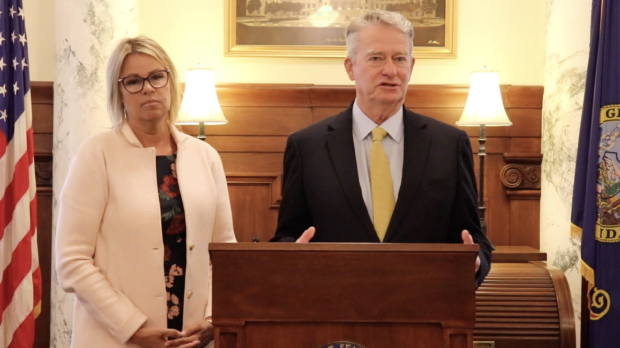A large portion of this year’s $381 million boost to Idaho public schools may be clawed back, after state officials rescinded a temporary formula that funded schools based on enrollment.
K-12 public school funding is again tied to attendance, and seat-time data from the first few months of the school year shows how much districts could lose compared to last year: nearly $162 million.
For decades before the COVID-19 pandemic, the formula that divides state funds for teacher and staff salaries and discretionary spending hinged on average daily attendance. When the coronavirus destabilized in-person learning, a temporary rule funded schools based on enrollment, a formula that school leaders have lobbied to make permanent for its predictability.
But the Legislature and the State Board of Education this year allowed the enrollment-based funding rule to expire. Most of the state’s 190 school districts and charter schools are set to lose money from the formula reversion.
“We knew and made our best attempts to warn state leaders that shifting back to attendance would bring a dramatic drop in how state funding is distributed, but it’s quite distressing to see the difference,” said Quinn Perry, policy and government affairs director for the Idaho School Boards Association.
How will the formula change affect your school?
The difference in formula funding won’t come as a surprise to school leaders, who have planned for it since May when they set budgets for the current school year. And big investments in teacher and staff pay and discretionary spending by the Legislature and Gov. Brad Little counterbalance the attendance-based funding cuts for many districts.
“A lot of that offset those losses, but it is a loss year-over-year if we had been on enrollment both years,” said Jonathan Gillen, chief financial officer for the West Ada School District, which faces an 8% drop in formula funding.

To see a breakdown of the differences between enrollment- and attendance-based funding in each school district, click here. Each allocation is calculated based on a “support unit,” a measurement that essentially represents a classroom.
Fifty school districts and charter schools — most smaller in size — stand to benefit from the attendance formula. When dividing the funds, the formula uses a larger divisor for higher attendance numbers, which favors smaller programs.
Statewide, attendance-based funding is 94% of enrollment. After “support units” are translated to dollars, the biggest cut — nearly $93 million — could come from career ladder salaries and benefits, taking a major chunk out of the state’s $145 million boost to the career ladder earlier this year.
Additionally, discretionary funding could be down $44.5 million, classified staff salaries and benefits down $16.7 million and administrative staff salaries and benefits down $7.7 million.
State leaders considering options to account for lost funds
The $162 million statewide budget cut isn’t a foregone conclusion.
State Superintendent Debbie Critchfield’s budget request, which lawmakers will consider in the upcoming session, includes $92 million to cover the losses. The request, submitted in September, underestimated the gap between attendance- and enrollment-based funding by about $70 million.
But Critchfield, a Republican, said this week that the state department now has “a more comprehensive understanding” of the attendance data and “will continue discussions…on next steps” with the governor’s office, legislators and other education stakeholders.

“I want our school districts and public charter schools to know that we at the Idaho Department of Education believe dollars that were appropriated for public schools should stay with public schools,” Critchfield said.
Little next week will present his budget recommendations to the Legislature. Little’s staff is evaluating the attendance data, and the governor “will make a budget recommendation in January that takes the trend line into account,” said Emily Callihan, Little’s communications director.
Callihan defended the recent “historic” investments in K-12 schools. The total public school budget nearly reached $2.7 billion, a 16% increase year-over-year.
“This included record investments in teacher pay and benefits, classified staff pay, and discretionary dollars to meet local needs,” Callihan said.
In 2022, Little vetoed a bill that would have kept enrollment-based funding through the current school year. The Republican has argued that tying school funds to attendance incentivizes in-person learning.
School leaders want permanent formula change
Meanwhile, superintendents and school board members for years have pushed to make enrollment-based funding permanent.

“School leaders are navigating a new world, post-pandemic,” Perry said. Children more often stay home when sick and parents expect more flexibility for their children to miss school, for a vacation or a mental health day, she said, “often without realizing that their absence results in an overall decrease in funding for their neighborhood schools.”
Critchfield, who has called the state’s funding formula “outdated,” last year convened a committee to again study potential changes. The task force has met several times but has yet to release a concrete recommendation on attendance- versus enrollment-based funding.
The School Boards Association last month urged lawmakers to take action this session. The group of hundreds of trustees from across the state passed a resolution calling on lawmakers to enact a new enrollment-based formula that’s stable and predictable.
“If lawmakers want to see their increased investments become reality back home in their public schools, it will take legislative action to correct this,” Perry said.
Idaho Education News data analyst Randy Schrader contributed to this report.
